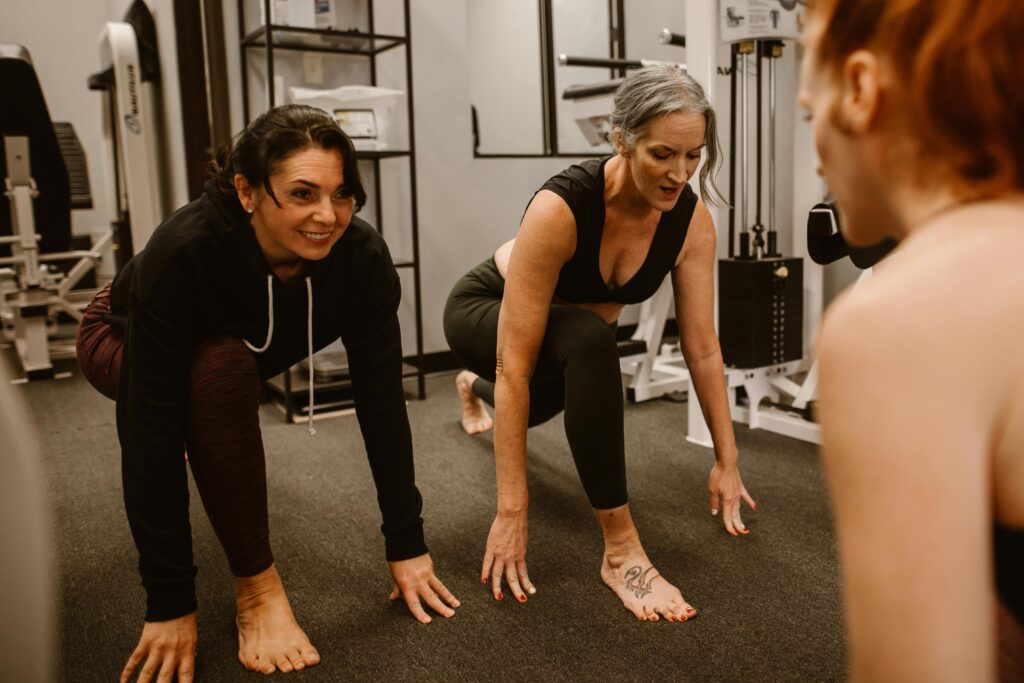You did a lot of hard work to bring a kid into the world, and your body deserves some gentle attention for the next few weeks. The goal is not to get a six pack in six weeks, but to have steady strength, vitality, and a clear mind. These tips come from pelvic floor therapists, postpartum trainers, and moms who have been through it all. Clear a space in the living room, put on supportive shoes, and let your living room become the safest gym you’ll ever need.

Gentle Foundations during the First Six Weeks
Take deep breaths to reconnect with your core
Put your legs up and your hands on your stomach while you lie on your back. Take a deep breath in with your nose to make your ribs spread out to the sides. Then, as you gently pull your navel toward your spine, breathe out through your lips. Three times a day, take ten slow breaths to retrain the diaphragm and deep core muscles that have been on vacation for nine months. The movement is not visible, but it initiates the interaction between the brain and the gut without any effort. Do this while the infant is sleeping or at the first feeding of the day when hormones are calm.
Take Short Walks Around the Couch
Don’t use the stroller for the first week. Just walk in a figure eight around the coffee table and couch. Five minutes twice a day gets circulation flowing, reduces swelling, and reminds the hips how to move again. Keep your shoulders back and picture a cord dragging the top of your head up to the ceiling. If you feel pressure in your pelvic floor, either shorten the loop or slow down. Every lap is a triumph lap for the uterus that worked hard.
Drink a lot of water like a marathon runner
Mothers who breastfeed lose an extra liter of fluid every day, and weariness typically hides thirst. Fill a thirty two ounce water bottle the night before and put it on the nightstand, the changing table, and the arm of the couch. Take a sip every time the baby eats and fill it up every time you change a diaper. Drinking enough water speeds up the mending of tissues, stops headaches, and keeps the milk production consistent. If plain water doesn’t taste good, you can add a minute pinch of sea salt and a squeeze of lemon to it to get electrolytes.
Six to twelve weeks for strength to come back
Body Weight Circuit While Your Baby Plays
Put the baby on a nice blanket with some toys and set a timer for 10 minutes. Do fifteen squats to chair height, twelve wall push ups, and fifteen glute bridges. Take a break for 30 seconds and then do the circuit again. To keep your core engaged, picture yourself zipping up tight jeans before every move. The infant likes to look at your face, and you can get stronger without leaving the room. You don’t need any extra equipment if you use a kitchen chair for support and a wall for push ups.
Lifts for the pelvic floor with support from the kitchen counter
Stand up straight at the counter with your hands resting on the edge. Breathe in and out slowly, then breathe out and lift your pelvic floor as if you were stopping the flow of pee. Count to five, let go for five, and do this ten times. The counter keeps things balanced, and the action develops the muscles that hold up the bladder and uterus. Do three sets throughout the day, maybe as you wait for coffee to make or milk to warm up.
After long feeds, stretch your hips and chest
Holding a baby for hours rounds the shoulders and makes the hip flexors tense. At a lunge stance, kneel on one knee and gradually press your hips forward until you feel a stretch at the front of your hip. Hold for thirty seconds, then switch sides. Then, put your hands behind your back and elevate your chest to stretch the tight muscles in your pecs. These two routines take two minutes and fix the bad posture that comes from marathon feeding marathons. Do this every time you finish a bottle or a nursing session.
Three to six months of building up speed
Resistance Band Rows Between the Wall and the Couch
Put a light resistance band around a strong table leg or stair post to hold it in place. Pull the band toward your ribcage fifteen times while sitting on the couch with your legs straight. The action strengthens the upper back and helps keep you from hunching forward as your baby grows. Do three sets while listening to an audiobook or your favorite podcast. The band is cheaper than a latte and can be stored in a drawer when not in use.
Mini Hops for Stronger Bones
Stand up straight and do modest ankle hops in place for 30 seconds. The light impact tells bones to heal after months of not being used as much. Wear footwear that supports you and make sure the landing is gentle, like jumping on a cloud. Take a break for 30 seconds, then do it five more times. The infant can either watch from the bouncer or join in if they like the music. If you feel any heaviness or leaking in your pelvis, stop.
Tall Planks for Core Stability
Put your hands on the couch seat and your feet on the floor to get into a tall plank position. Breathe into your diaphragm and hold for twenty seconds. The incline takes pressure off the abdominal wall and lets the core work securely. Over the next few weeks, work up to three rounds of thirty seconds each. Keep your spine long and your hips from drooping. This exercise builds up your strength for push ups and lifting things every day.
Functional Power for Six to Nine Months
Press and squat with a stroller
Put the infant in the stroller and hold the handlebars with both hands. Do a squating position until your thighs are completely or as much as you can, parallel to the floor, and then stand up and push the stroller forward. The move combines power in the lower body with stability in the shoulders that you use every day. Do three sets of fifteen reps throughout your morning walk. Pick a flat sidewalk and lock the wheels of the stroller before you start. The baby likes the fresh air and the steady rocking.
Lunges with a diaper bag on your back
Put two big water bottles in the diaper bag to make it lighter. With the bag in front rack position, go down the corridor while doing lunges. The extra weight makes it harder to balance and work the core, just like carrying a baby. Do ten lunges with each leg, then do three more rounds. As you get stronger, you can change the weight by adding or taking away bottles.
Side Plank for Strength in the Obliques
Lay on your side with your knees bent and your elbow beneath your shoulder. Raise your hips so that there is a straight line from your head to your knees, and hold it for twenty seconds. Do three rounds on each side. The action works the obliques, which help stabilize the spine when you carry a baby on one side. When the bent knee variant gets comfortable, move on to straightening the legs.
Return to Intensity in Nine to Twelve Months
Interval Training with a Baby Monitor
Put the baby monitor on the coffee table and do ten rounds of thirty seconds of jumping jacks followed by thirty seconds of rest. The quick bursts safely elevate your heart rate, and the monitor keeps you linked. Pick a time when the baby is sleeping in the morning so you can focus on your form. If you feel any pressure in your pelvis, pause and keep the landing soft.
Core Stability with Dead Bugs
Put your arms and legs up at a right angle while lying on your back. Keep your lower back pressed to the floor and slowly move your right arm or limb and left leg away from your body. Do ten reps on each side, then switch sides. The move works your core without crunches and lowers the chance of diastasis recti. Listen to a favorite playlist while you do two sets.
Farmer Carries Grocery Bags
Put books or cans in two reusable grocery bags and carry them up and down the hall. For thirty seconds, keep your shoulders back and your chest up. Take a break and do it three times. The workout helps you get a better grip and shows you how to raise car seats and diaper boxes the right way. Start with a few books, then add more as you get stronger.
Extra Tips for Staying Consistent
Plan workouts like meals
Just like you do with doctor appointments, write down when you will work out. Ten minutes after the first morning meal or during the afternoon sleep is when you should do your sacred movement. If you treat the slot as non negotiable, your family will learn to respect the line. Three brief sessions spread out during the day are better than one large sweat session.
Responsibility for Partners
Take ten minute pauses to move about with a partner or acquaintance. Send each other a selfie after each session and celebrate minor victories together. The social support keeps people motivated and makes exercising a group activity instead of a burden.
Celebrate Your Non Scale Wins
Keep following and track your mood, energy levels, and how many flights of stairs you can climb without pausing. Pay attention to when the car seat feels lighter or when you can run after a toddler across the yard without being out of breath. These wins are more important than any number on a scale.
Conclusion
After pregnancy, getting healthy is like a flower that takes a long time to grow. It rewards you for being patient, consistent, and gentle to your changing body. Start with breathing, then add gentle walks, and finally develop strength as the weeks go by. You already have everything you need to feel strong, clear headed, and ready for the next adventure that comes with being a mother in your living room, hallway, and walkway.



